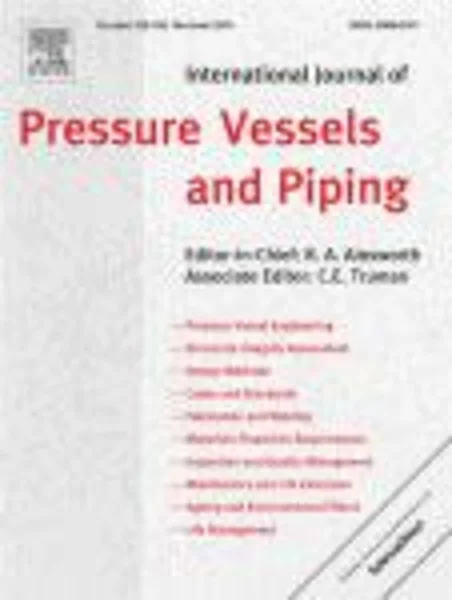-
determination of the elastic-plastic fracture mechanics z-factor for alloy 182 weld metal flaws
جزئیات بیشتر مقاله- تاریخ ارائه: 1390/01/01
- تاریخ انتشار در تی پی بین: 1390/01/01
- تعداد بازدید: 727
- تعداد پرسش و پاسخ ها: 0
- شماره تماس دبیرخانه رویداد: -
one of the ways that the asme section xi code incorporates elastic-plastic fracture mechanics (epfm) in the section xi appendix c flaw evaluation procedures for circumferential cracks is through a parameter called z-factor. this parameter allows the simpler limit-load (or net-section-collapse) solutions to be used with a multiplier from epfm analyses. this paper shows how 3-d finite element (fe) analyses were employed to investigate the sensitivity of the crack-driving force as a function of crack location (i.e., crack in the center of weld, or closer to the stainless or low alloy steel sides) in an alloy 182 dissimilar metal weld (dmw), and how an appropriate (or equivalent) stress-strain curve was determined for use in the j-estimation schemes. the j-estimation schemes are then used to cover a wider range of variables, i.e., pipe diameters, cracks lengths, and also incorporate crack growth by ductile tearing. the z-factor equations as a function of pipe diameter were calculated using the lbb.eng2 j-estimation scheme along with the most conservative equivalent stress-strain curve from the fe analyses. the proposed z-factor approach was then validated against an alloy 182 dmw full-scale pipe test that had a circumferential through-wall crack in the fusion line. the predicted epfm maximum load showed excellent agreement with the experimental result. furthermore, it was shown that the proposed z-factor equation is not sensitive to the location of the crack.
مقالات جدیدترین رویدادها
-
استفاده از تحلیل اهمیت-عملکرد در ارائه الگوی مدیریت خلاقیت سازمانی و ارائه راهکار جهت بهبود
-
بررسی تاثیر ارزش وجوه نقد مازاد بر ساختار سرمایه شرکت های پذیرفته شده در بورس اوراق بهادار تهران
-
بررسی تأثیر سطح افشای ریسک بر قرارداد بدهی شرکت های پذیرفته شده در بورس اوراق بهادار تهران
-
بررسی تأثیر رتبه بندی اعتباری مبتنی بر مدل امتیاز بازار نوظهور بر نقد شوندگی سهام با تأکید بر خصوصی سازی شرکت ها
-
تأثیر آمیخته بازاریابی پوشاک ایرانی بر تصویر ذهنی مشتری پوشاک ایرانی (هاکوپیان)
-
نقش چشمه های آبگرم معدنی در رونق گردشگری با تاکید بر شهرستان مشکین شهر
-
مطالعه سیاست جنایی مشارکتی ایران در پیشگیری از قاچاق کالا و ارز
-
مطالعه تجربی تاثیرات نسبت های اختلاط و سن نمونه بر مشخصات مکانیکی بتن پلاستیک با استفاده از آزمایش سه محوری
-
مرتب سازی اسپایک های عصبی با استفاده از شبکه عصبی بدون استخراج ویژگی
-
بررسی گسترش خرافات و جادوگری در ایران با تاکید بر دوران صفویه و قاجاریه
مقالات جدیدترین ژورنال ها
-
مدیریت و بررسی افسردگی دانش آموزان دختر مقطع متوسطه دوم در دروان کرونا در شهرستان دزفول
-
مدیریت و بررسی خرد سیاسی در اندیشه ی فردوسی در ادب ایران
-
واکاوی و مدیریت توصیفی قلمدان(جاکلیدی)ضریح در موزه آستان قدس رضوی
-
بررسی تاثیر خلاقیت، دانش و انگیزه کارکنان بر پیشنهادات نوآورانه کارکنان ( مورد مطالعه: هتل های 3 و 4 ستاره استان کرمان)
-
بررسی تاثیر کیفیت سیستم های اطلاعاتی بر تصمیم گیری موفق در شرکتهای تولیدی استان اصفهان (مورد مطالعه: مدیران شرکتهای تولیدی استان اصفهان)
-
جرم شناسی جنوب
-
تنقیح مناط کتاب تاریخ تشیع در غرب اسلامی پس از شانزده سال، جامعه شناسی سیاسی دولت
-
تحلیل تفسیری مفهوم «صراط مستقیم» در سوره فاتحه با تمرکز بر تفسیر المیزان علامۀ طباطبایی رحمۀ الله علیه
-
environmental and economic analysis of selected pavement preservation treatments
-
preparation and characterization of tio2 fe2o3 nanocomposite by sol gel method




سوال خود را در مورد این مقاله مطرح نمایید :